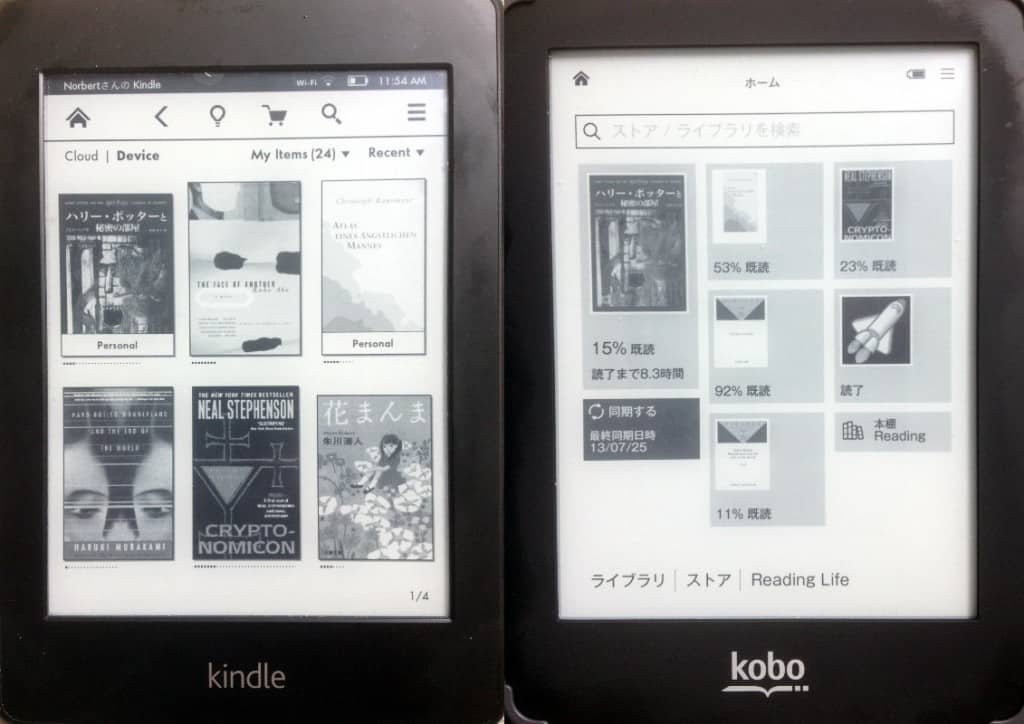There are already a lot of articles out there in the net comparing the two devices. Having quite similar specs I found that the reading experience with both units is very similar, as long as one stays with Roman character books. This article focuses on reading Japanese with the units and try to compare them.
Peculiarities of Japanese text
I will not give a full introduction to the specifics of reading Japanese, one can consult the excellent W3C Working Draft Requirements of Japanese Text Layout, or my slides Typesetting with Kanji (used during a conference in Guanghzou and at TUG 2012 in Boston). I only want to mention the following points that one needs to understand in the following comparison:
- writing/reading direction: Japanese prose is often written from top to bottom, from right to left. So the first kanji on a page is the one in the top right corner. As a consequences books are read from right to left, page turns go from left to right.
- various writing modes: Japanese uses at least three different glyph sets in parallel: Hiragana (ひらがな, mostly used for grammatical distinctions and some additional words), Katakana (カタカナ, used to transcribe foreign words), and Kanji (漢字, used for the main part of the text).
- word separation: There is no word separation done by inserting empty space. The full text is normally written without any separation of words.
![ruby-example]()
- Ruby: small Hiragana characters attached to words written in Kanji to provide the pronounciation (see the image on the right for an example)
Japanese text and eBooks
Kindle’s format (azw) went through some revisions, since 2011 with the format described as azw3 or kf8 it is able to do html5 and css3, thus gaining the ability to display Japanese text in vertical mode properly.
Kobo’s main format is epub, which since revision epub3 supports Japanese layout. In reality what is now shipped in Kobo Japanese books is called kepub which contains additional Javascript (besides others I guess).
Both being basically at the level of epub3/html5/css the abilities are quite similar. Here are two screenshot of more or less the same page in Harry Potter, left on the Paperwhite, right on the Kindle:
Text and page layout
As you can see above, the quality of fonts and resolution are very similar, nothing to complain here. The only thing that is disturbing, and often remarked in forums, is that the Glo leaves a wider margin, even when I set it to minimum margin range. The effect is that the rows are shorter.
Selection and dictionary lookup
(Update 2014: With the release of firmware 3.2.0 the selection process on the Kobo has improved considerably and is now on par with the Kindle. See this blog post for details and screen shots!)
Here the Kindle beats the Glo by far, unfortunately. Let us first look at how selection works:
- Paperwhite: tap&hold on the screen selects the largest connected set of glyphs of the same type (Hiragana, Katakana, Kanji, see above). If necessary, the selection can be adjusted later two handles at the end of the selection.
- Glo: tap&hold does nothing. One has to tap-hold-move to the next character. This procedure is very error prone. No automatic selection here. I normally need four to five trials until I get it right. (Note that this behaviour is peculiar for Japanese text. With Roman text words are properly selected automatically.)
Now for lookup in the dictionary. As mentioned in this article, I have installed a Japanese-English dictionary for the Kindle. For the moment this is not possible with the Glo (although there are some hacks), so on the Glo I would get the Japanese-Japanese dictionary.
- Paperwhite: the translation immediately pops up in a small transient window. Content depends on the selected dictionary.
- Glo: One has to tap the dictionary symbol at the bottom bar, then select dictionary. After that a full screen window appears.
Conclusion
With respect to the quality of display the two units are very similar, only that the Glo uses the screen space less efficient. As long as you don’t need select/lookup in Japanese books, the reading experience is also very similar.
But when it comes to selection and dictionary lookup in Japanese text, the Paperwhite beats the Glo by far. And since I have to lookup words quite often, I use the Kindle for Japanese text, and both units for all the other books.























